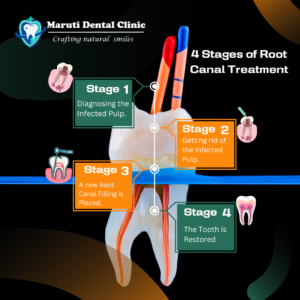Root canal treatment is a dental procedure designed to save a tooth that is badly infected or damaged. During the root canal treatment procedure, the dentist removes the infected tissue, cleans the inner part of the tooth, and seals it to prevent further infection. This procedure helps preserve your natural tooth, avoiding the need for extraction and ensuring long-term dental health.

What is a Root Canal Treatment?
A root canal treatment, also known as endodontic therapy, is a dental procedure designed to treat the inside of a tooth when the pulp—the soft tissue containing nerves and blood vessels—becomes inflamed, infected, or damaged. This treatment involves removing the infected pulp, cleaning the root canals, and sealing them to prevent further issues.
Signs You Might Need a Root Canal
It’s important to notice the symptoms of a tooth infection so you can get treated on time. Common signs include:
- Continuous toothache or sensitivity to hot and cold foods.
- Pain when chewing or biting.
- Swollen or tender gums near the tooth.
- Tooth discoloration or darkening.
- Small bumps or pimples on the gums.
If you have any of these symptoms, visit your dentist right away.
What are the 4 Stages of Root Canal Treatment Procedure?
Understanding the stages of a root canal can make the process less intimidating. Here are the three main stages:
-
Diagnosis & Preparation

The dentist examines the tooth using X-rays to assess the extent of infection. Local anesthesia is administered to numb the area, ensuring a painless procedure. A rubber dam is placed around the tooth to keep it dry.
-
Cleaning the Tooth
The first step is to remove the infected or damaged pulp. The dentist numbs the area, makes an opening in the tooth, and carefully cleans out the pulp from the canals.
-
Filling the Canals
After cleaning, the dentist shapes the canals and fills them with a biocompatible material called gutta-percha. This material seals the canals to prevent future infections.
-
Restoring the Tooth
Finally, the dentist places a filling or crown on the tooth to protect it and restore its normal function. This step ensures the tooth remains strong and can last a lifetime.
How Long Does the Root Canal Treatment Procedure Take?
The time needed for a root canal depends on the condition of your tooth. Most treatments are completed in one or two visits, each lasting about 1 to 1.5 hours. Your dentist will let you know the exact timeline.
Is Root Canal Treatment Painful?
Many people think root canals are painful, but this is a myth. With today’s dental technology and anesthesia, the procedure is almost painless. In fact, it’s similar to getting a regular filling.
During the root canal procedure, you won’t feel any pain because the tooth is numbed. After the treatment, you may feel mild discomfort or sensitivity for a few days, but this can be easily managed with over-the-counter painkillers and usually subsides quickly.
Addressing Common Myths About Root Canal Treatment Procedure
Despite its reputation, modern root canal therapy is relatively painless, thanks to advancements in dental techniques and anesthesia. Let’s debunk some common myths:
- Myth: Root canal treatments are extremely painful.
Fact: Most patients report that the procedure feels similar to getting a filling.
2. Myth: Extracting the tooth is a better option.
Fact: Saving your natural tooth is usually the best choice for long-term oral health.
3. Myth: Root canals require multiple, lengthy visits.
Fact: Many treatments can be completed in one or two appointments.
Benefits of Root Canal Treatment Procedure
Here’s why getting a root canal is a good decision:
- Saves Your Natural Tooth: A root canal lets you keep your original tooth instead of losing it.
- Relieves Pain: It removes the infection, which is the source of the pain.
- Prevents Further Infection: Cleaning out the infected pulp stops the problem from spreading.
- Long-Term Solution: With proper care, a treated tooth can last a lifetime.
Tips for Post-Treatment Care
Taking care of your teeth after a root canal is important. Follow these tips:
- Avoid chewing on the treated tooth until the permanent crown is placed.
- Brush and floss regularly to keep your teeth clean.
- Visit your dentist for regular check-ups to ensure the tooth stays healthy.
- Stay away from hard or sticky foods that could damage the temporary filling.
When to Call Your Dentist?
Though problems are rare, contact your dentist if:
- You have severe pain that doesn’t go away.
- Swelling worsens or spreads.
- You notice signs of reinfection, like a bad taste or new bumps on the gums.
Conclusion:
A root canal treatment procedure is a safe and effective way to save a tooth that’s badly infected or damaged. By understanding the process and trusting your dentist, you can face the procedure with confidence.
If you think you need a root canal, don’t delay. Early treatment can save your tooth and prevent further problems. Book a consultation with our dentist today and take the first step toward a healthier smile!



